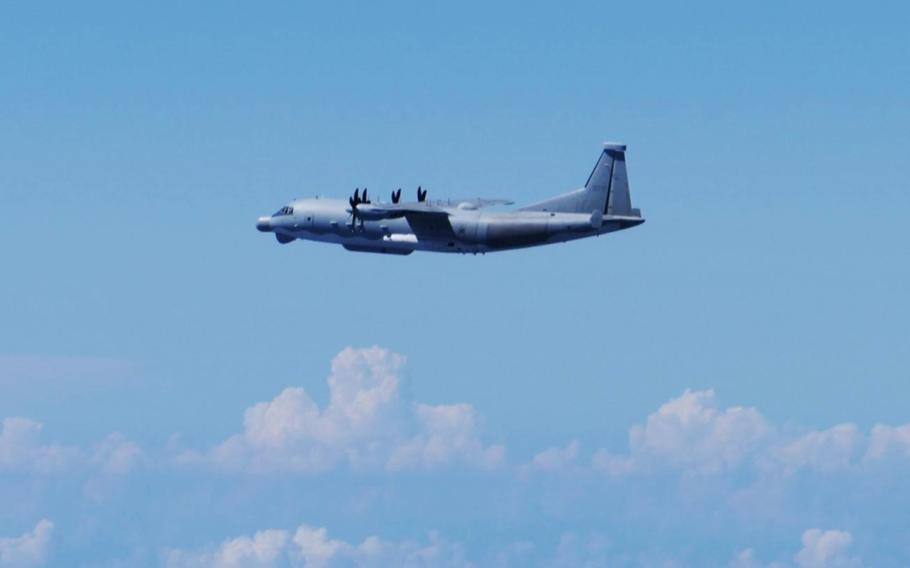
A Chinese Y-9 surveillance plane enters Japanese airspace on Monday, Aug. 26, 2024. (Japanese Ministry of Defense)
TOKYO — Japan through diplomatic channels protested as “completely unacceptable” the first-ever incursion into its airspace by a Chinese military aircraft this week.
A Chinese Y-9 surveillance plane flew into Japanese airspace around 11:30 a.m. Monday just southeast of the Danjo Islands, about 100 miles southwest of Nagasaki, according to a Defense Ministry news release that day.
In response, Japan scrambled Mitsubishi F-2 and F-15 Eagle fighter jets to intercept the aircraft and broadcast radio warnings, a Joint Staff spokesman told Stars and Stripes by phone Tuesday.
He offered no further details other than to confirm no weapons, warning shots or signal flares were used. Some Japanese government officials may speak to media only on condition of anonymity
The flight was a “grave violation” of Japan’s sovereignty and a threat to its security, Defense Minister Minoru Kihara said during a Tuesday press conference.
“It is completely unacceptable,” he said. “We filed extremely severe protests through diplomatic channels on the same day and strongly asked for measures to prevent recurrences.”
Chinese military activities near Japan appear to be “expanding and intensifying,” Kihara said.
Tokyo plans to closely monitor Chinese military activity and will continue to scramble aircraft against future Chinese incursions into Japanese airspace, he added.
Chief Cabinet Secretary Yoshimasa Hayashi during the press conference described the Chinese flight as the first “confirmed and announced” intrusion by China since Japan began scrambling its fighters against intruding aircraft.
He declined to speculate on the Chinese aircraft’s mission or comment on whether the incident would affect relations between the two countries.
U.S. Ambassador to Japan Rahm Emanuel in a post Tuesday on social platform X alluded to previous incidents involving Chinese coast guard vessels ramming and firing water cannons at Philippine ships in the South China Sea.
“There’s little ‘love thy neighbor’ in China’s ‘good neighbor’ policy,” his post states.
Chinese aircraft not affiliated with its military have made at least two unauthorized flights into Japanese airspace in the past 12 years.
An aircraft from China’s now-dissolved State Oceanic Administration entered airspace near the contested Senkaku Islands in December 2012, according to a Defense Ministry report of aircraft sorties. Japan administers the handful of islets, which China also claims.
In May 2017, an unmanned aircraft entered the same area, according to a ministry report.
On Monday, about the same time the Y-9 flew close to Danjo Islands, South Korea reported a Y-9 in its air defense identification zone, according to a spokesman for the country’s Joint Chiefs of Staff.
The aircraft flew near Socotra Rock, also known as Ieodo, about 100 miles southeast of Jeju Island, the spokesman told Stars and Stripes by phone Tuesday. Government spokespeople in South Korea customarily speak to the media on condition of anonymity.
The flight was not viewed as unusual because South Korea’s ADIZ overlaps China’s and Japan’s in that area, and Chinese aircraft regularly enter the area, the spokesman said.
An ADIZ is not always recognized but aircraft are expected to identify themselves in the interest of national security.
Before the Chinese surveillance plane entered the area, the South Korean military identified and monitored it and dispatched fighter jets to escort it, according to the spokesman.
The surveillance plane entered the ADIZ while the U.S.-South Korean military exercise Ulchi Freedom Shield is underway, but the spokesman said the Joint Chiefs do not believe the two are connected.
Stars and Stripes reporter Yoo Kyong Chang contributed to this report.